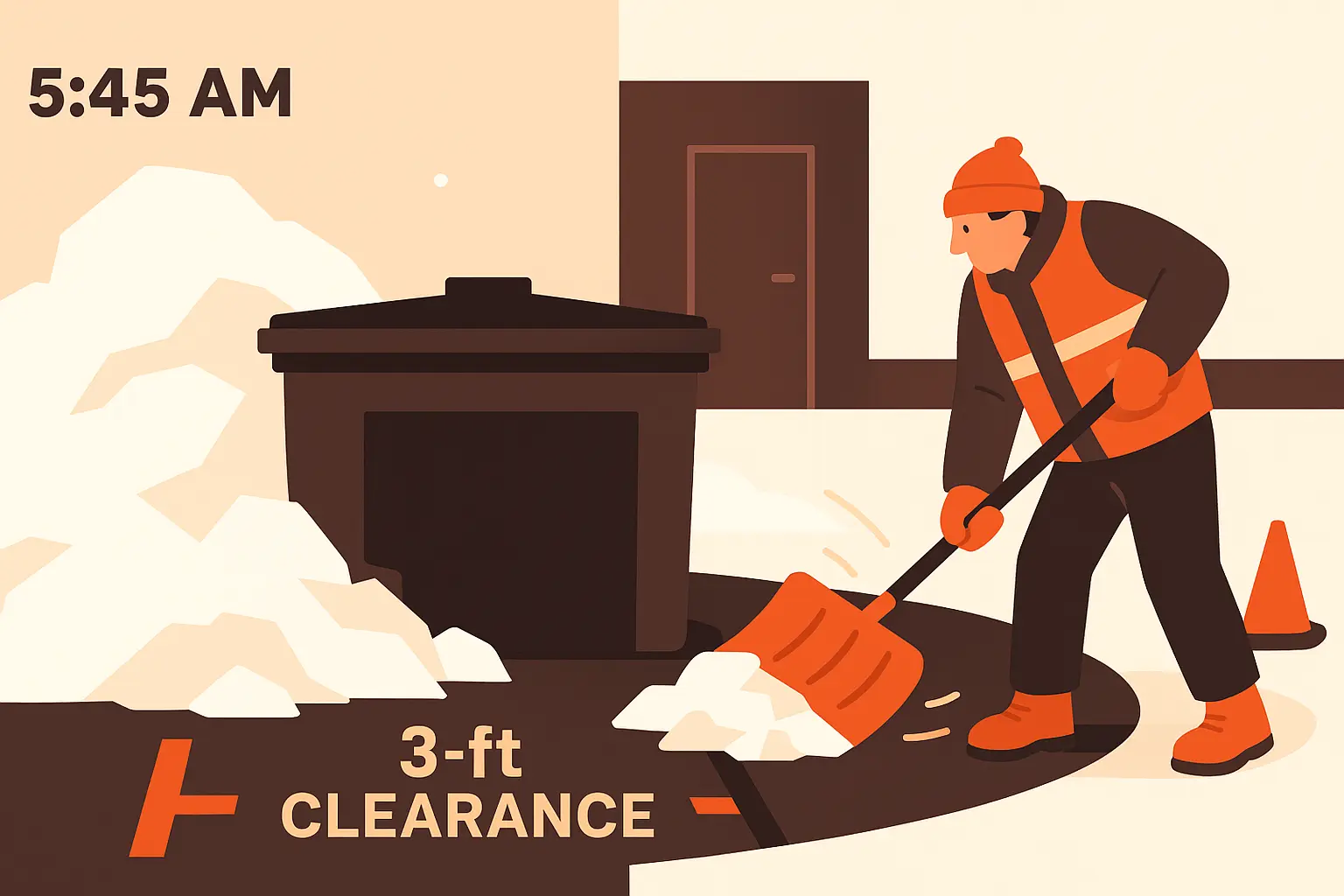Table of Contents
Why NJ Winters Turn Liquid Fryer Oil Solid Overnight
Vegetable oil begins to gel around 40 °F; below 15 °F waxes crystalize, clogging lines. Outdoor tanks cool faster than indoor kettles, so a January cold snap can hard freeze 200 lb of oil by dawn, halting kitchens and backing up traps. Heated containers holding ≥59 °F avoid wax formation.

Snow Banking Your Grease Tank? Clear Paths Fast
Plows pile snow against back door enclosures, burying lids and locking service hooks. One blocked valve can push pickups back three routes. According to winter service studies, crews lose 8 to 12 minutes per stop when tanks aren’t shoveled out. Grease Connections texts a 24 hr storm checklist so staff clear a 3 ft radius path before trucks arrive.
Salt Eats Steel: Container Materials that Survive De Icing Brine
Road salt spray reaches loading bays even a mile from highways. Chlorides pit un coated carbon steel within one season. Polyethylene or 304 stainless out last bare steel by 5 to 7 × in salt fog tests.
| Container Wall | Salt Spray Lifespan* | Annual Maintenance |
|---|---|---|
| Bare carbon steel | 1 winter | Monthly repaint |
| 304 stainless | 6 + winters | Rinse quarterly |
| HD polyethylene | 8 + winters | Inspect seals |
*Approximate field data from corrosion studies.
Built In Heat: Coils, Insulation, and Smart Sensors Keep Oil Moving
Steam or electric coils mounted inside bulk tanks raise oil 25 °F in 30 min. When grid power is absent, double wall foam totes hold ≥50 °F for 24 hr at 20 °C. Wi Fi sensors ping our dispatch if oil drops under 45 °F so a tech can swap a heater sleeve before lines freeze.
Beating Storm Delays & Road Bans: Scheduling Pickups the Grease Connections Way
NJDOT bans trucks on select highways when forecasts call for 2 in + snow or gusts over 40 mph. Grease Connections stages smaller Class B trucks south of the ban line and sends alerts through the NJDOT geofence system for real time detours. Kitchens choose “pre storm,” “mid storm,” or “recovery day” windows to guarantee removal within 48 hr.
| Storm Phase | Pickup Window | Typical Capacity |
|---|---|---|
| Pre storm | 12 hr before snow | 90 % on time |
| Mid storm | During light snow (<1″) | 70 % on time |
| Recovery day | 6 to 24 hr after plows | 95 % on time |
Keep Kitchen Lines from Freezing Before They Reach the Tank
Uninsulated flex lines under ½ inch freeze first. Keeping the kitchen port above 50 °F and running a 5 second hot oil purge each close keeps flow paths clear. Where exterior piping is unavoidable, we sleeve it in heat trace cable rated to 20 °F.
Winter Sludge: How Traps Fill Faster and What to Do About It
Cold temps harden FOG, causing heavier mats that settle in the interceptor. Sludge build up can double in six weeks if pump outs stay on a 90 day summer cycle. Move to a 45 day winter schedule or install biological digester blocks that stay active down to 40 °F.
Safety First: Spill Response & EPA Compliance in Cold Weather
Frozen oil shards are slip hazards; a quart spill can spread 20 sq ft on ice. OSHA cold weather spill guidance recommends sand based absorbent and heated wash water to avoid icy films. Grease Connections supplies spill kits with calcium chloride free grit to protect concrete and storm drains.
Serving Every New Jersey City in NJ with 24 Hour Winter Support
Whether it’s Newark winter grease pickup, New Jersey City cold fryer oil recycle,” or Elizabeth de icing safe tank, our local fleet stays within 60 miles of every major metro. GPS routes, heated bulk containers, and 24/7 support keep fryer oil moving even when Route 80 closes. Book a winter readiness audit at no charge and let Grease Connections turn snow days into smooth days.









